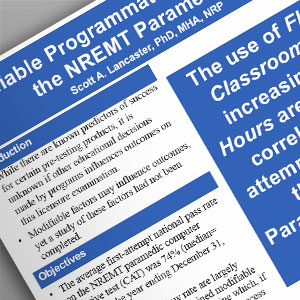ABSTRACTS
Modifiable Programmatic Factors as Predictors of Success on the NREMT Paramedic Cognitive ExaminationAuthor: Scott Lancaster PhD, MHA, NRP | | Northern Essex Community College Associate Authors: Stoy, Walt PhD, EMT-P | Duty, Susan ScD, RN | Strowman, Shelly PhD
Introduction It is unknown why the National Registry of Emergency Medical Technicians (NREMT) Paramedic cognitive examination pass rates fall below other allied health programs or what aspects of paramedic programs might predict success on the NREMT examination. One reason might be the lack of standardization of program design. Paramedic educational models vary greatly, not only across the country, but within states. The aim of this study is to access the association between modifiable programmatic variables in Commission on Accreditation of Allied Health Education Programs (CAAHEP) accredited paramedic programs and first-attempt pass rates on the NREMT paramedic cognitive examination. Hypothesis Modifiable programmatic factors, such as program delivery method; total class room, clinical, and field hours; program staffing patterns; use of prerequisite courses; and other factors impact the education received by paramedic students and therefore have an effect on program outcomes on the NREMT paramedic examination. Methods Using a cross-sectional census survey methodology, CAAHEP accredited paramedic programs in the United States were recruited to participate in an online survey which included 22 modifiable programmatic factors (independent variables), two non-modifiable factors (for demographic purposes) and the programs first-attempt pass rate on the NREMT paramedic cognitive exam in 2017 (outcome variable). Results Of the 585 eligible programs recruited, 278 programs (49.1%) completed the survey and were included in the data analysis. Descriptive statistics were produced for each variable, inferential statistics were produced for variables by high / low pass rate groups, and univariate logistic regressions were completed to identify possible factors for inclusion in the final model: eight variables remained for inclusion. A multivariate logistic regression model (R2=0.087) retained three variables including number of field hours (OR=1.001, p=0.041), use of flipped classroom (OR=1.872, p=0.026), and computer-based testing (CBT) use (OR=0.293, p=0.026). Conclusion This study was the first to examine the numerous modifiable programmatic predictors of success on the NREMT among accredited paramedic programs. Three significant predictors remained in the model, indication a possible association between pass rates and increased field hours and use of flipped classroom. Interestingly, use of CBT was negatively associated with success, which needs further study.
|

